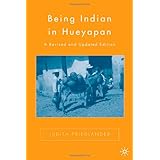
Average Reviews:

(More customer reviews)Are you looking to buy Being Indian in Hueyapan: A Revised and Updated Edition? Here is the right place to find the great deals. we can offer discounts of up to 90% on Being Indian in Hueyapan: A Revised and Updated Edition. Check out the link below:
>> Click Here to See Compare Prices and Get the Best Offers
Being Indian in Hueyapan: A Revised and Updated Edition ReviewMost North Americans who fly to Cabo San Lucas, the boom town at the tip of Baja California, land at the airport of San Jose del Cabo, a small but comfortably isolated and sanitized access point to their luxury condos and time shares, which now line the beach for a stretch of thirty miles. If you fly from a secondary Mexican city, however, you'll land in a different world, at the municipal airport of Cabo San Lucas itself. You'll have ample opportunity to look down upon the sprawling squatter town - tiny shacks made of scrap metal and thatch, as crowded and squalid as the slums of Mumbai - that surrounds the airport. There are no rental-car agencies at this airport, and if you want a taxi, you'll have to ask the señorita at the currency exchange window to call one for you. This vision of abject poverty has the 'disadvantage' of being accessible; if you really want to see how wretchedly millions of people are living in Mexico, you'll have to work harder and take some risks by visiting the slums of the capital, DF, on the dry bed of lake Texcoco. Believe me, no taxi driver will take you there.Why are so many people so desperately impoverished and marginalized in Mexico? Tourist, anyone you encounter - the waiter, the hotel maid, even the guy selling throw-rugs on the beach - is 'middle-class' in comparison to the truly miserable that you don't see! Understanding just how desperate people are in Mexico might give you a different feeling about 'illegal' immigration. If your great-great-grandparents in Sicily or Silesia were that desperate, you'd be proud of them for having braved the ocean to get to the USA.
Anthropologist Judith Friedlander went to the village of Hueyapan, in central Mexico, in 1969, to study an "Indian" culture where the Nahuatl language was still in use. What she discovered over the course of a year in residence and several return visits to Hueyapan was that 'being Indian' in Mexico was more a question of economic status than of culture. To simplify her nuanced perceptions, one might say that if you're poor enough, you're 'indio', and if you're rich enough, you're 'blanco.' That's what she expresses in the subtitle of her book: "A Study of Forced Identity in Contemporary Mexico."
Freidlander's insights began to crystalize when she realized exactly how little about "indian" culture was indigenous, and how much of it was the legacy of European conquest, of the forced conversion to Christianity and the education imposed by the Spanish missionaries. Studying clothes, food, and crafts, Friedlander found that the Indians of Hueyapan were at good deal closer in lifestyle to peasants in Spain in the 16th Century than to their genetic Aztec ancestors. Some of her findings are mind-boggling; the 'native' cure for bronchitis, for example, contains six herbs of European origin, butter, and white wine; the only indigenous ingredient is tomatillo, green tomato. And the prayer that accompanies this cure, recited by the local old witchy 'curandera' translates from Nahuatl thus: "Saint Bartholomew of Castile, you who come on a horse, take this shadow from its place."
Frielander arrived in Mexico City expecting, with utter naivete, to share in the movement of revivification of pre-conquest culture that she had been told about. Waht she found, on the ground, profoundly disillusioned her. The movement in DF was not grass-roots or village-based, but rather a projection of students and middle-class urban Mexicans -- mestizos to be sure, but attracted by a romantic image of Mexicanness that made no room for the plodding poor. That disillusionment was only her first; in the long run, she became passionately critical of the role government agencies have continually played in forcing the identity of poverty upon the rural masses, and eventually equally critical of the effect anthropologists - the modern missionaries - have had in the villages they've staked out for their well-funded careers.
This is a very interesting book and, at 188 pages, not a burdensome academic text. No other study of almost-contemporary Mexico has chimed so realistically with my own observations of the country as a student and traveler there. I believe I'll order a new copy through amazon, to be delivered to the Obamas at their Washington address!Being Indian in Hueyapan: A Revised and Updated Edition Overview
Want to learn more information about Being Indian in Hueyapan: A Revised and Updated Edition?
>> Click Here to See All Customer Reviews & Ratings Now
0 comments:
Post a Comment